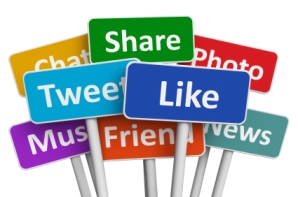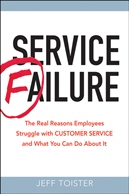They have a job, so why do they blog?
 Jeff Toister
Jeff Toister  Tuesday, June 25, 2013 at 8:16AM |
Tuesday, June 25, 2013 at 8:16AM |  There are a lot of people who actively share their thoughts about customer service via blogs, Twitter, Facebook, and other online platforms. Most of them, including me, are consultants, speakers, or authors. It stands to reason that people like us would actively share our voice online. After all, we’re trying to get the word out.
There are a lot of people who actively share their thoughts about customer service via blogs, Twitter, Facebook, and other online platforms. Most of them, including me, are consultants, speakers, or authors. It stands to reason that people like us would actively share our voice online. After all, we’re trying to get the word out.
But what motivates people who already have a job working for someone else?
To learn the answer, I reached out to four internal employees who are all prolific contributors to the online discussion about customer service.
Jenny Dempsey and Jeremy Watkin
Jenny and Jeremy are part of the customer service team at Phone.com. Jenny is the Customer Service Supervisor and self-described Phone.com mascot while Jeremy is the Director of Customer Service.
The two of them embody the spirit of customer service on their fabulous Communicate Better Blog. It features insights into the service they provide their own customers at Phone.com plus examples from other companies and frequent guest posts. They also Tweet from @commbetterblog.
Jenny and Jeremy told me they are active online because it helps them learn, it adds purpose to their work, and helps them define their service culture at Phone.com.
Learning
Jeremy: “When you stop and think about it, everyone has customers and there is customer service both good and bad going on all around us. What an amazing opportunity to learn! Selfishly, this exercise helps me be a better husband, father, employee, coworker, boss and friend to my customers as I learn to serve better.“
Jenny: "I do this because I want to help others in the best way I possibly can. I want to learn and grow and be totally awesome at helping others!"
Purpose
Jenny: “Writing this blog gives me a sense of purpose at my job and in life (sounds cheesy, but it does). It opens my eyes to the fact I’m doing something bigger than just answering a call or writing an email. I am ridiculously inspired on a daily basis.”
Culture
Jeremy: “I do want to help build a customer-centric culture at Phone.com and find that this is a fantastic way to inspire our customer service team. I talk a lot about "awesome" customer service. Still others on our team are excited to contribute guest posts and comments about what they are learning about customer service. Even more exciting is when people in other departments in our company read our blog and talk about how they are changing the way they approach their customers.”
Annette Franz (Gleneicki)
Annette serves as Director, Customer Experience Management Strategy at Confirmit.
Her entertaining and informative CX Journey blog focuses on customer experience. She’s not afraid to be provocative and I like that I agree with her perspective most of the time, but not always. She often uses personal stories backed by research to make her point and also includes guest bloggers on a regular basis. Annette also Tweets from @cxjourney and @annettefranz.
I wasn’t surprised to learn Annette’s top two reasons for sharing her thoughts online since it’s evident in her style, but she has several more great reasons too.
- I love to write!
- I’m passionate about what I do.
- I’m building my personal brand.
- Blogging is a way to share my learnings and experiences from the last 20+ years.
- While there are many of us who do what I do, I think there is power in numbers. The more of us who try to get the message out, the better.
- It allows me to help others that I might not otherwise meet through my corporate role/position; from students to start-ups to corporate practitioners, I’ve met, answered questions for, and provided guidance one-on-one to people who follow me on social media and are regular readers of my blog.
- It’s a great way to meet like-minded individuals and to learn from others.
Bill Quiseng
Bill is the Resort Manager at Marriott’s Ko Olina Beach Club in Oahu, Hawaii.
If you wanted to use Twitter as tool for keeping up with the latest customer service trends, you could follow Bill Quiseng (@billquiseng) and do quite well. That’s because Bill is constantly sharing and re-Tweeting great customer service ideas and content. He also does an amazing job populating his Facebook page with interesting topics and discussions too.
Bill views sharing customer service lessons with others as a way of paying it forward for the all the great mentoring he’s received in his career.
“I really have enjoyed my 35 years in the hospitality industry, almost all of that time in the luxury resort segment. I have been mentored by some of the very best general managers of luxury resorts. And those GM's all taught the same key lesson:
With only slight differences in the product or setting between our resort and our competitors, the key differentiators are in the personalized service our front line associates deliver and the overall guest experience we create through their collective guest interactions.
I write to serve as a mentor to those who want to perfect their delivery of the customer experience. As a person reads each blog post, they learn a little more, until over time, they become masters of customer service. And that is how I'd like to "pay it forward" for a lifetime career of having learned from some of the very best in delivering an exceptional customer experience.
These people are real pros
Writing a blog post like this is often a numbers game. You ask a lot of people you’d like to hear from knowing only a handful will respond.
This group is different. These four are the only people I reached out to because I knew they’d reply quickly and thoughtfully. They’re all true customer service professionals whose passion for sharing and helping others is authentic, and I truly appreciate their contributions.








